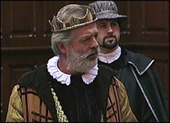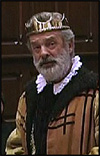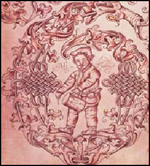-
Edition:
 King Leir
King Leir
King Leir
- Introduction
- Texts of this edition
- Contextual materials
1King Leir, Scene 1
Cast
Skalliger: David Kynaston
King Leir: Don Allison
First Lord: Phil Borg
Perillus: Peter Higginson
Performing King Leir: Psychology, Acting and Parts
2 The opening scene of the first play in the SQM company's repertoire, Scene 1 of King Leir became a testing ground for our working process. The company of actors had only just been introduced to Elizabethan rehearsal practices and our initial approach to the opening scenes of King Leir followed the conventional pattern of twenty-first century rehearsal with which they were all familiar. Don Allison (Leir) was initially bemused by the text, finding it difficult to understand and impossible to memorize. In an interview on the Performing the Queen's Men website Allison describes how his response was colored by a recent experience with Shakespeare's Lear. To him the text of the Queen's Men play lacked "poetry" and coherence: he struggled to understand it and especially to put the lines into the "emotional context" of the character he was charged with playing.
3The scene provides conflicting information about Leir's state of mind, which puzzled Allison and led to much exploratory work. The syntax in the opening speech, for example, is convoluted to the point of obfuscating the sense and proved extremely difficult to memorize as Leir skips from one thought to the next without making the connections clear (![]() TLN 1-29). Working past Don's initial response that the speech was badly written and a pale precursor of Shakespeare, we took the position that the disruptions in the speech must be signs of Leir's grief at the loss of his wife. Later in the scene, however, Leir is suddenly eloquent and decisive (
TLN 1-29). Working past Don's initial response that the speech was badly written and a pale precursor of Shakespeare, we took the position that the disruptions in the speech must be signs of Leir's grief at the loss of his wife. Later in the scene, however, Leir is suddenly eloquent and decisive (![]() TLN 39-42) appearing to be a statesman in full control of his faculties. Having given the impression in his opening speech that he is incapable of dealing with his daughters, Leir then reveals that he has already made clear plans and is pleased that they are echoed by the nameless Nobleman (
TLN 39-42) appearing to be a statesman in full control of his faculties. Having given the impression in his opening speech that he is incapable of dealing with his daughters, Leir then reveals that he has already made clear plans and is pleased that they are echoed by the nameless Nobleman (![]() TLN 56-58). This shift struck Allison as an inconsistency that required attention. Is Leir really overwhelmed by grief when he comes to the scene with a plan for his daughters already in place? Allison experimented with the idea that Leir was an expert political manipulator and that his initial speech was in part a performance of grief and helplessness intended to elicit support for his political agenda from his courtiers. This strategy was playable but undermined Leir's affection for his wife and made his character less appealing.
TLN 56-58). This shift struck Allison as an inconsistency that required attention. Is Leir really overwhelmed by grief when he comes to the scene with a plan for his daughters already in place? Allison experimented with the idea that Leir was an expert political manipulator and that his initial speech was in part a performance of grief and helplessness intended to elicit support for his political agenda from his courtiers. This strategy was playable but undermined Leir's affection for his wife and made his character less appealing.
4 We then pushed the scene in the opposite direction, experimenting with more extreme expressions of grief, creating a version of Leir verging on madness. In rehearsal this seemed at odds with the clear assertion and execution of his authority at other moments in the scene. Furthermore, the opening speech contains so many important plot points there was a limit on how far he could push this grief. We needed the audience to understand what he was saying. As the ramblings of a grieving man this speech makes psychological sense but as the introduction to Leir's character and a means to communicate important past events, its lack of clarity was problematic.
5 Much time was invested in this scene and gradually Allison brought the two poles of his interpretation together and performed Leir as a shrewd and capable king who was feeling increasingly unsure of himself since the death of his queen. He was pleased to find his nobles' wishes concurred with his own plans and was emboldened to think of ways to deal with his one disobedient daughter Cordella, but his emotional fragility was apparent. When Perillus challenged his plan for Cordella, Don delivered the line "I am resolved" with vehemence (![]() TLN 77). The disastrous "sudden stratagem" (
TLN 77). The disastrous "sudden stratagem" (![]() TLN 78) of the love test was understood as a product of his grief.
TLN 78) of the love test was understood as a product of his grief.
6The process described here has more to say about the twenty-first century acting techniques than about the play or the original company. In keeping with our training, Allison and I collected all the pieces of evidence in the text and related them to each other in order to develop a performance that felt psychologically consistent. Having done this work Allison was able to place Leir's lines within the "emotional context" he had built and perform them with conviction. This approach to acting has been developed in the relative luxury of the modern rehearsal room but the original actors did not dedicate the same time to ensemble rehearsal. From what we understand of Elizabethan rehearsal, actors worked on their parts alone and generated performances in response to the rhetoric found in their characters' speeches. Don is an experienced classical actor and he too was responding to the variety of rhetorical devices and styles employed by the playwright but even in the relatively pressured SQM rehearsal process he had more time to arrange the pieces into what felt like a complete and consistent characterization before walking on stage in front of a live audience.
7 When the original Queen's Men actors approached the same material alone and without access to the entire text, the sense of consistency and unity, necessary to give the actor the confidence to step out on stage and play a character, must have been built on other ground. Working on the SQM productions I came to the conclusion that they must have relied on the notion that each character was a type of part. In this case, Don is playing a "king" and each of his speeches is a rhetorical action performed by a king: the king grieves, the king asserts his authority, the king hatches a plot and so forth. The nature of the action is defined by the rhetoric of the part that is designed to have a particular effect on the listener. An actor knowing how to play the part of a king need only study the rhetoric of his part to understand the specific intentions of each speech. Performed in sequence the speeches tell the story of a grieving king, trying to manage his daughters alone for the first time, and making what will prove to be a disastrous decision. Taking such an approach the performance of the king need not be less complex than Allison's but the route to achieving it would be more direct.
8 Early modern actors likely did not spend time developing the particularities and idiosyncrasies of a unique character psychology and were thus able to perform a larger repertoire and prepare plays for the stage more quickly. The Queen's Men plays were not necessarily conceived in such terms and the SQM company found that removing the idea that each character should be a unique individual from the actor's work saved a lot of time and was a major factor in enabling the company to get the three plays on their feet with, what was for them, relatively little rehearsal. In the case of this scene, such an approach would have been more direct, by-passing exploration of character psychology, and would still have allowed for complexity, since the complexity is contained in the rhetoric of Leir's various speeches. Reflecting on his experience working on the SQM productions, Peter Higginson (Perillus) noted that the key factor was the intense focus on the text.
Watch video of the opening scene on the Performing the Queen's Men website. (The video footage is password protected. Click on "Cancel" in the pop-up window to obtain password.)
The Queen's Men and Shakespeare
9Shakespeare's plays, Lear, while using the same arguments, is more consistently eloquent and commanding in the opening scene. King Lear's emotional instability is made apparent from the start, but the daughters are left to observe "how full of changes [Lear's] age is" (F: TLN 314) and to suggest that "he hath ever but slenderly known himself" (F: TLN 318-9). Leir's opening scene gives the majority of attention to the king's grief, the political problem of succession, and the wisdom of the proposed course of action, but Shakespeare's play shows more interest in the issue of Lear's character. In the following scene in the Queen's Men play, the sisters are driven by their jealous hatred of Cordella rather than doubts about their father's judgment and age.
Watch video of the opening scene on the Performing the Queen's Men website. (The video footage is password protected. Click on "Cancel" in the pop-up window to obtain password.)
Performing Skalliger: Type characters and the Twenty-First Century actor
10 David Kynaston's development of the role of Skalliger is another good example of the relative efficiency of performing stock character types rather than investing time in the psychological motivation of characters. Skalliger is established as a Machiavel character at the end of this scene and in the next scene; following Elizabethan tradition, we dressed him in black to indicate the nature of his character. David, however, wanted more detail. In this scene, he was particularly interested in the fact that Leir appears to have given him a special license to speak (![]() TLN 34). When was he given this license? Did they have a previous meeting addressing this issue or is he personalizing the general license to give advice contained in Leir's first speech (
TLN 34). When was he given this license? Did they have a previous meeting addressing this issue or is he personalizing the general license to give advice contained in Leir's first speech (![]() TLN 7)? These were questions that were important to David as he worked to individuate his character. Early modern actors would have approached this character as the type of the Machiavel and built their performance from there.
TLN 7)? These were questions that were important to David as he worked to individuate his character. Early modern actors would have approached this character as the type of the Machiavel and built their performance from there.
Read about David's performance of Skalliger in scene 2 [[ edition links should not have query or fragment parts ]].
Watch video of the opening scene of the play on the Performing the Queen's Men website. (The video footage is password protected. Click on "Cancel" in the pop-up window to obtain password.)







